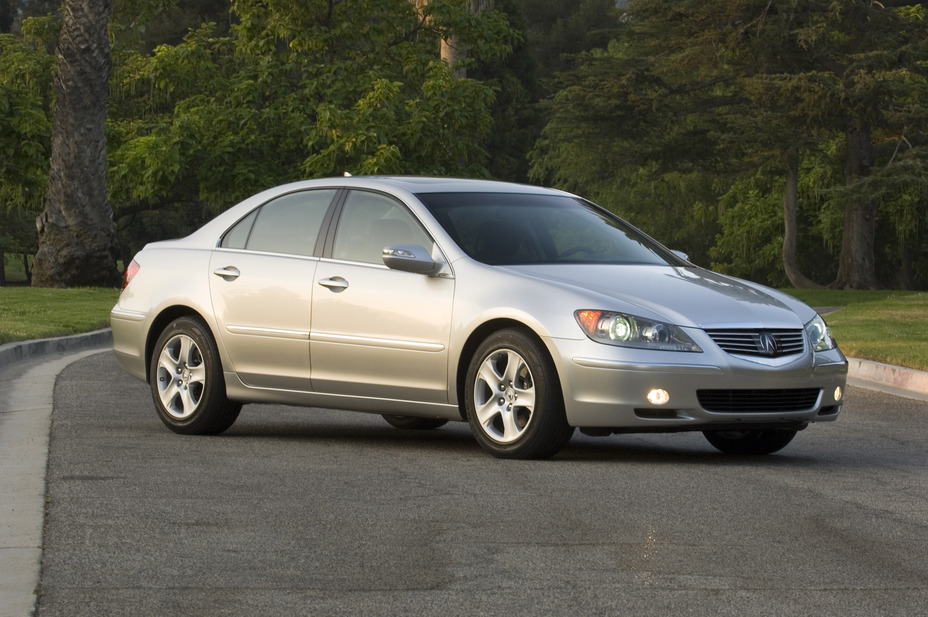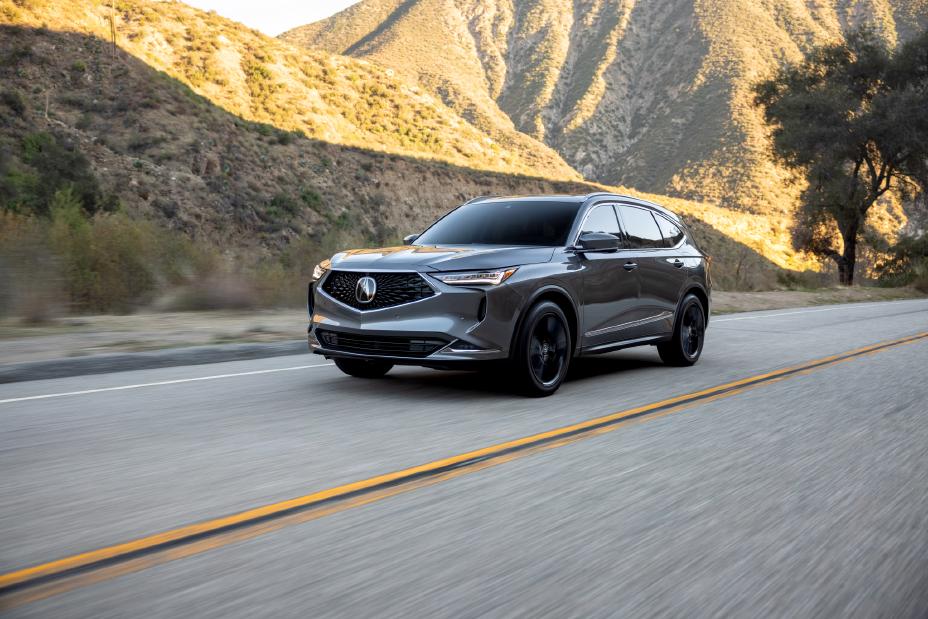- AcuraWatch™ is the brand's exclusive Advanced Driver Assistance System (ADAS)
- Acura pioneered automatic emergency braking with addition of Collision Mitigation Braking System™ (CMBS™) on the 2006 Acura RL
- AcuraWatch™ is now standard on every Acura sedan and SUV model today
Fulfilling Acura's commitment to "safety through innovation", AcuraWatch™, the brand's exclusive Advanced Driver Assistance System (ADAS), is standard equipment on every Acura sedan and SUV. AcuraWatch™ helps to improve the driver's situational awareness and, in certain circumstances, intervenes to help avoid a collision or mitigate its severity.
It was on the 2006 Acura RL that Acura introduced the industry's first automatic emergency braking (AEB) system. Designed to detect the potential for a collision and mitigate the severity of collisions that could not be avoided, the Collision Mitigation Braking System™, or CMBS™, was the first step toward creating a comprehensive suite of driver assistive and safety technologies.
2006 Acura RL with Technology Package featuring Collision Mitigation Braking System™
AcuraWatch™ is that full suite of Advanced Driver Assistance System (ADAS) technologies. First introduced on the 2015 Acura TLX, AcuraWatch™ employs advanced "sensor fusion" technology, using the combined sensing capabilities of a millimeter-wave radar mounted behind the grille and a monocular camera mounted at the top of the windshield to help maintain the vehicle's position in traffic and to prevent or mitigate the severity of a collision.
Representing a technological bridge to the automated driving technology of the future, AcuraWatch™ continues to improve and expand. Today, the AcuraWatch suite of technologies includes Collision Mitigation Braking System™ (CMBS™) with Forward Collision Warning (FCW); Road Departure Mitigation (RDM) with Lane Departure Warning (LDW); Lane Keeping Assist System (LKAS); and Adaptive Cruise Control (ACC) with Low-Speed Follow (LSF). Some newer Acura models also include Traffic Jam Assist (TJA), Traffic Sign Recognition (TSR), and a driver attention monitor.
It is important to note that as with any ADAS feature, AcuraWatch™ is not intended to replace the driver's assessment of traffic conditions and control of the vehicle. The driver must intervene in certain situations and must always be attentive when using the system. In addition, drivers have the option of turning off some or all of the various functions.
2022 MDX with standard AcuraWatch™
Collision Mitigation Braking System™ (CMBS™)
Collision Mitigation Braking System™ (CMBS™) alerts the driver when it determines there is the potential for a collision, and then automatically applies emergency braking to help avoid or reduce the severity of a collision if drivers don't take corrective action on their own. On some Acura models, CMBS™ includes pedestrian sensing and automatic emergency braking (Pedestrian AEB).
Detecting vehicles and pedestrians falls to the millimeter wave radar unit and monocular camera. This fusion of radar and camera sensors allows the system to effectively detect the nature, distance and speed of obstacles to determine whether there's a potential for a collision.
When CMBS™ determines there is potential for a collision, visual and audible alerts prompt the driver to take corrective actions. The visual alerts appear on the digital screen on the instrument panel, and Head-Up Display (if equipped). If the system determines that a collision is imminent, it applies the brakes to help reduce vehicle speed and eventual collision forces.
Although in many cases CMBS™ will stop the car, it is not intended to apply enough braking force to prevent all collisions. Based on the conditions, the system also may not perform all visual- and audible-alert stages, and may instead automatically engage the brakes if the system deems it necessary.
Forward Collision Warning (FCW) — Integrated with CMBS™
Forward Collision Warning (FCW) uses the monocular camera to detect vehicles and pedestrians ahead and to determine whether a collision is imminent. If the FCW system detects a vehicle or pedestrian in front of the vehicle and the speed differential between the vehicle and object indicates a collision may occur, it will sound an audible alert and trigger a visual warning on the instrument panel and Head-Up Display (if equipped). If CMBS™ is also activated and the driver fails to respond, the vehicle's brakes will be automatically applied if the system determines a collision is imminent.
Drivers may adjust the distance at which FCW alerts occur and may choose between "Long," "Normal," or "Short." FCW cannot detect all objects ahead; accuracy will vary based on weather, speed and other factors.
Road Departure Mitigation (RDM) with Lane Departure Warning (LDW)
Road Departure Mitigation (RDM) uses the monocular camera to identify solid or dashed painted lane lines, Botts' dots and cat's eye markers. RDM uses both steering force and braking force to help the vehicle stay in its lane.
The monocular camera recognizes lane features and identifies the lane. If the RDM system detects that the vehicle is about to leave the detected lane, it displays a visual Lane Departure Warning (LDW) on the instrument panel. If the driver does not respond, the system will produce a warning and take corrective action by providing steering assist, and in rare occasions when steering is not sufficient, braking assist, to help the driver stay on the road.
Road Departure Mitigation also has a customizable initial warning of either a steering wheel vibration or an audible alert. The system can be customized in the vehicle settings, with the following choices available:
- Normal mode — Activates steering assist and steering wheel vibration or audible warning simultaneously.
- Wide mode — Activates steering wheel vibration or audible warning before steering assist.
- Narrow mode — When equipped, activates steering assist before steering wheel vibration or audible warning.
- Warn Only mode — Activates steering wheel vibration or audible warning only (no steering assist).
Lane Keeping Assist System (LKAS)
Lane Keeping Assist System (LKAS) provides a less stressful driving experience by reducing steering correction movements and driving effort on the highway, from approximately 45 to 90 mph. LKAS uses a camera to read lane markings and uses the electric power steering (EPS) to assist the driver in keeping in the middle of the lane.
Designed for the U.S. road structure, the system uses the monocular camera to identify solid or dashed painted lines, Botts' dots and cat's-eye markers. When LKAS senses that the driver is drifting from the middle of a detected lane, the system generates corrective steering torque to assist the driver in maintaining lane position.
Adaptive Cruise Control (ACC)
Adaptive Cruise Control (ACC) allows the driver to set a desired speed and following interval behind a vehicle detected ahead, allowing the use of cruise control in light highway traffic conditions. This significantly reduces the stress of driving in traffic. The system uses millimeter wave radar and a monocular camera to continually track the distance to the vehicle ahead, and then adjusts the vehicle's speed to maintain the driver-selected following interval. A short, medium, long, or extra-long interval can be selected. When required, the vehicle automatically brakes to maintain the set interval.
Low-Speed Follow (LSF)
Low Speed Follow (LSF) extends the automatic following capability of ACC to stop-and-go traffic situations (down to 0 mph). ACC with Low-Speed Follow functions include the following:
- A preceding vehicle is detected in the lane ahead — Decelerates automatically, if required, and then controls the following interval.
- The preceding vehicle slows to a stop — Stops automatically and remains stationary.
- The preceding vehicle accelerates from a stop — Resumes following when the SET or RES switch or accelerator pedal is operated.
- Another vehicle is detected merging in between the Acura and the preceding vehicle — Automatically switches "targets" to the nearest detected vehicle.
- The preceding vehicle exits the lane — ACC with low-speed follow system continues at cruise-control speed previously selected by driver (25 to 90 mph).
Traffic Jam Assist (TJA)
Traffic Jam Assist (TJA) works in conjunction with LKAS, providing light steering assist all the way to a complete stop if needed. Operating at speeds below 45 mph, TJA helps the driver maintain lane position when traveling at slower speeds, such as might be experienced in congested traffic conditions. Traffic Jam Assist is activated when both ACC and LKAS are enabled on the steering wheel and will function when a preceding vehicle and lane markers are detected.
Traffic Sign Recognition (TSR)
Some Acura models include a camera-based Traffic Sign Recognition (TSR) feature that supports the driver in recognizing traffic speed limit signs. The monocular camera can automatically recognize speed limit signs and display the information on the instrument panel, and on the Head-Up Display (if equipped). The information is displayed immediately after the vehicle passes the sign. Drivers may select between using TSR and the navigation system's speed-limit information.
Driver Attention Monitor
A Driver Attention Monitor is featured on some Acura models. It continually monitors and assesses driver behavior behind the wheel to help determine if the driver is becoming inattentive. If the system determines the driver is tired or inattentive, it issues a warning on the gauge panel for the driver to take a break. The system uses input from Electric Power Steering (EPS) to measure both the frequency and severity of the driver's steering inputs to gauge their level of awareness with four gradients.
When the Driver Attention Monitor is activated, the driver is first alerted by a coffee cup icon and a 4-level bar graph that is displayed on the digital screen on the instrument panel. The bar graph indicates full attention when four white bar elements are illuminated. As the driver's attention drops, fewer and fewer bars are illuminated. When the number of bars drops to two, a message inviting the driver to take a break is illuminated. If the driver continues driving and the graph drops to the lowest level of one bar, a beeper sounds and the steering wheel vibrates, prompting the driver to pay closer attention or take a rest break.
Enhanced Safety & Driver Assistive Features
The standard AcuraWatch™ suite of safety and driver assistive technologies on the 2024 Acura TLX and 2025 MDX has been updated for enhanced performance, with expanded functions of a new front single-lens sensor camera with higher detection accuracy and a wider 90-degree field of view (up from 50-degrees) plus a new grille-mounted millimeter-wave radar with a wider 120-degree field of view (up from 50-degrees). The significantly more capable hardware improves collision avoidance performance via improved ability to recognize attributes of objects, such as vehicles, bicycles or pedestrians, as well as white lines and road boundaries like curbs and road signs.
In the rear, the blind spot information (BSI) system's warning range has increased to 82 feet, enabling Lane Change Alert, which can help alert the driver to detected vehicles approaching from behind in adjacent lanes.
On TLX, the standard AcuraWatch™ suite of safety and driver-assistive technologies includes Collision Mitigation Braking System™ (CMBS™) with Pedestrian Detection, Adaptive Cruise Control with Low-Speed Follow, Forward Collision Warning, Road Departure Mitigation (RDM) incorporating Lane Departure Warning (LDW), Lane Keeping Assist System (LKAS) and the Traffic Sign Recognition System.
On MDX, the AcuraWatch™ suite of safety and driver-assistive technologies includes CMBS™ with Pedestrian Detection, Adaptive Cruise Control with Low-Speed Follow, Forward Collision Warning, Road Departure Mitigation (RDM) incorporating Lane Departure Warning (LDW), LKAS and the Traffic Sign Recognition System. Adaptive Cruise Control with Cornering Speed Assist, which determines curvature of the lane and reduces vehicle speed when ACC is active, is new to all MDX models.
The new 2025 MDX Type S with Advance Package introduces a new more advanced AcuraWatch™ 360 suite of safety and driver-assistive technologies with multiple new driver assistance features and capabilities.
# # #



